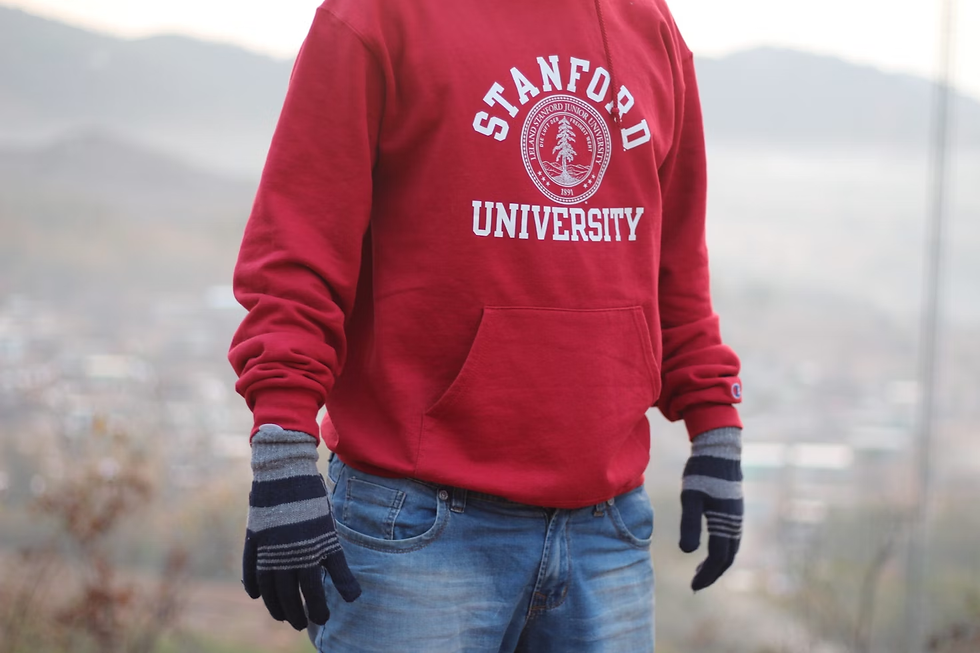The Evolution of Spirit Wear: From Tradition to Trend
- Katie Pierce

- Jul 7
- 3 min read
From the beginning, spirit wear has never been just a piece of apparel. This type of clothing has functioned as an outward representation of solidarity, pride, and belonging since the days of pep rallies and varsity jackets, and up until the emergence of casual hoodies and stylish joggers.

However, what originally only symbolized school pride has changed over time to become something far more vibrant. Spirit wear now exists at the nexus of personal expression, utility, and fashion. This development demonstrates how tradition and trend may coexist harmoniously to maintain the style's relevance while maintaining individuality.
The traditional role of spirit wear
The earliest styles of spirit clothing were associated with school and community traditions. More than just articles of apparel, letterman jackets, team jerseys, and class T-shirts served as symbols of respect and pride. Often designed with school colors, logos, and slogans that visually united a student body or sports team, these clothes had a uniform design and were easily distinguished.
These items, worn at rallies, games, or special "spirit days," served to define a common experience. From one generation to the next, they established continuity.
You were a part of something bigger when you wore your school's emblem: a team, a community, a heritage. Because of its consistency, even the most basic cotton T-shirt conveyed a sense of solidarity among its wearers.
The integration of spirit wear into everyday fashion
With fashion getting more expressive and inclusive, traditional spirit wear started to change. These days, you won’t be surprised to see students wearing school-branded sweatshirts in hallways, coffee shops, or weekend outings. This shift can be attributed in part to athleisure and the desire for fashionable comfort.
Spirit wear started borrowing elements from streetwear and performance apparel. Think oversized fits, cropped cuts, and muted palettes alongside the usual bold colors. The result? Garments that maintain their symbolic meaning but also blend effortlessly into everyday style.
Many of these updates reflect how custom apparel plays a key role in showcasing group identity and unity while keeping up with evolving fashion trends. People want clothes that say something about who they are, but also align with current style aesthetics. Once constrained by tradition, spirit wear is now influenced by contemporary fashion.
Spirit wear as self-expression and personal style
More than just a group uniform, spirit wear today is increasingly a platform for self-expression. The capacity to personalize clothing turns a common symbol into something that holds personal significance. This change is in line with a wider cultural movement that embraces uniqueness while maintaining a sense of self.
Students no longer have to choose between fitting in and standing out. With the right design, they can do both. Many are using spirit wear to reflect their flair, customizing pieces with personal touches that say, “This is mine,” while still representing their team or school.
This creative freedom encourages people to create their unique, personal style without letting go of the communal aspect of spirit wear. It’s a balance between the personal and the collective, a style evolution that mirrors how people define identity today.
The influence of modern branding culture
Another significant driver of spirit wear’s evolution is the influence of branding culture. Schools, teams, and even student organizations are now treating spirit wear with the same thoughtfulness as a small business might approach its merchandise line. The goal is not just representation, but also engagement and visibility.
Gone are the days of a single shirt design for the entire year. Many institutions now release spirit wear collections — capsule drops timed around events, seasons, or milestones. They work with graphic designers or production companies to develop designs that are new, wearable, and trend-aware. These efforts also make spirit wear more appealing to students, faculty and even alumni, families, and fans.
This commercialization doesn’t exist to make money, it exists to build community through style. People wear the brand proudly — be it for a university, club, or local team — strengthening the emotional bonds and creating long-term loyalty. Spirit wear has become a style-savvy statement thanks to branding.
Conclusion
Compared to the typical polos and uniform jerseys of previous decades, spirit wear has evolved significantly. But despite its evolution, its fundamental goal of uniting people never changes. The shift from tradition to trend is a reinvention rather than a loss of significance. Spirit wear of today allows people to celebrate their shared identity while embracing their individuality.
In many ways, this journey reflects how fashion itself is changing. People want more than just clothes. They want connection, creativity, and meaning. Spirit wear now offers all three.
By blending timeless symbolism with modern style, it has become more relevant than ever. As the lines between community and individuality blur, spirit wear will keep adapting — faithful to its roots, but always ready for what’s next.




Comments